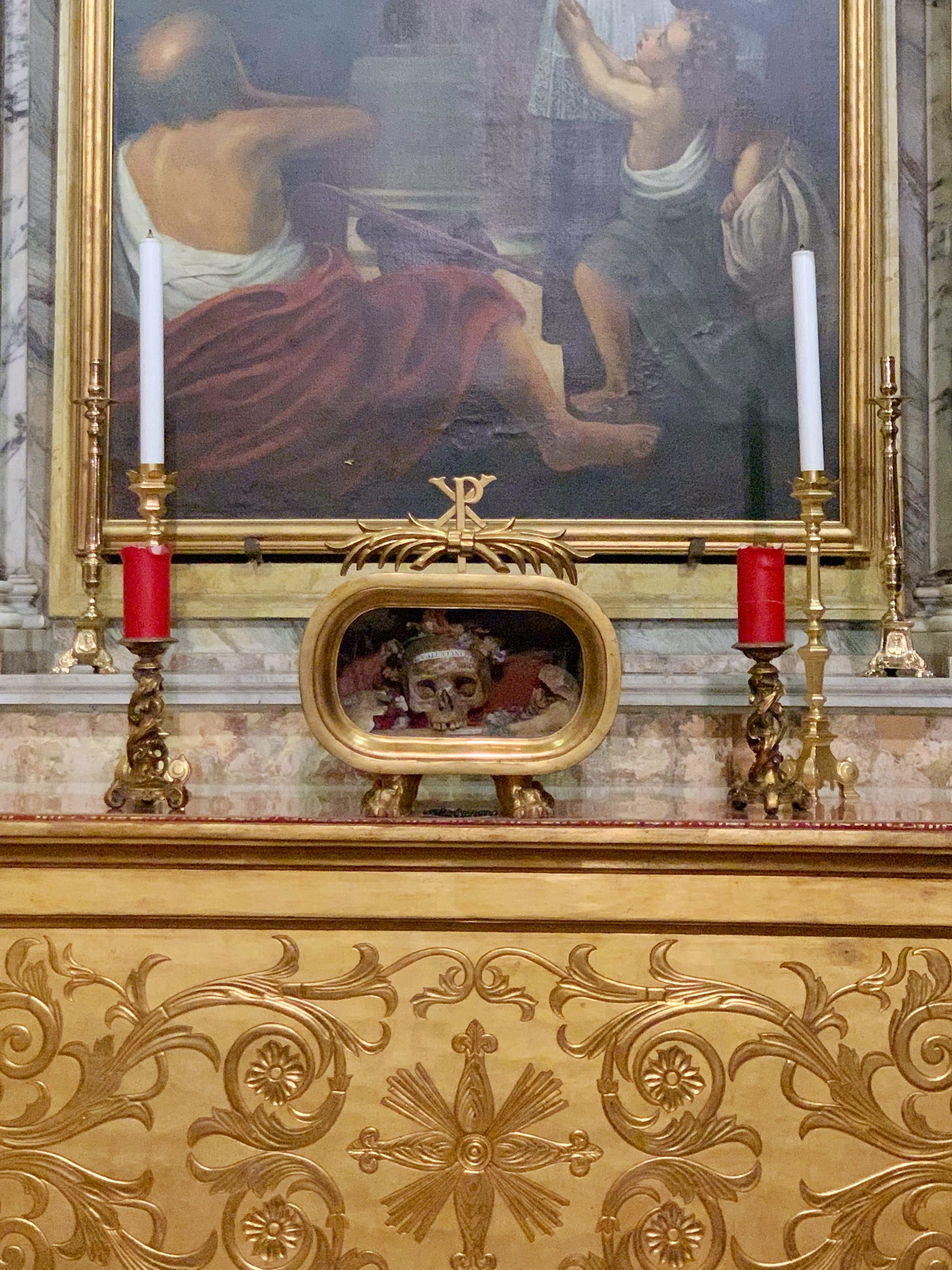Long before Hallmark turned Valentine’s Day into the commercial juggernaut it is today, there likely was a real Saint Valentine, or two Saint Valentines—no one is actually sure. Sources from the Middle Ages refer to a Saint Valentine of Rome and a Saint Valentine of Terni (a small city in Umbria), who both supposedly lived in the 3rd century C.E. and secretly officiated marriages against the will of the emperor Claudius II. Both were martyred when they refused to renounce Christianity for paganism somewhere along the Via Flaminia, the ancient road that goes north from Rome toward Umbria. Some scholars believe it was actually the same saint, whose story was duplicated and celebrated by different religious cults in Rome and Terni.
As the legend goes, when the saint (or saints—these details apply to both Saint Valentine of Rome and Saint Valentine of Terni) was imprisoned for his crimes, he befriended (or fell in love with) his captor’s daughter and cured her of her blindness. The whole family then converted to Christianity, but that didn’t save poor Valentine—he was tortured and beheaded nonetheless, but not before he could write a note to the young woman signed “your Valentine.”

The remains of Saint Valentine were supposedly buried in a catacomb on Via Flaminia, in the present day neighborhood of Parioli in Rome, and a cult formed to worship him. Of course, Terni also claims to have the relics of Saint Valentine buried in a tomb on the outskirts of the city.
And to complicate things even further, the skull of Saint Valentine is supposedly kept at the Basilica di Santa Maria in Cosmedin near the Circus Maximus in Rome, where every year on February 14, it’s taken out and decorated with a crown of flowers. To be fair, it’s plausible that the two churches in Rome and the church in Terni could all have Saint Valentine’s relics, as saints’ relics were often distributed to several different churches, sometimes in different countries.
But regardless of who Saint Valentine may have been, the holiday that bears his name likely originates even farther back in history—and in its first incarnation, it celebrated sex and fertility rather than love and romance.
“As you may know, Valentine’s Day corresponds to the festival of Lupercalia, which was a rather peculiar festival where there were sex scenes and orgies,” explains Elisa Valeria Bove, archeologist and CEO of Roma Experience. “It was considered an ugly festival by the Christians, so they wanted to substitute it during the Middle Ages with that of Saint Valentine.”
As Bove tells it, Lupercalia was celebrated by pagans around February 13-15 as a passage toward a new awakening and the fertility of the land. Its origins trace all the way back to the legend of Romulus and Remus, who were suckled by a she-wolf in a den they later named Lupercus on the Palatine Hill, where Romulus went on to found Rome. Supposedly, Lupercalia was a festival created to honor the she-wolf and please the Roman fertility god Lupercus.
According to History.com, Lupercalia began with the ritual sacrifice of one or more male goats and a dog in the Lupercal cave on the Palatine Hill. Then two naked Roman priests called Luperci would have the animals’ blood smeared on their foreheads using the sacrificial knife. The blood would then be removed with a piece of milk-soaked wool as the Luperci laughed, and after that the feasting would begin. Afterwards, the Luperci would cut strips of the goat hide and run naked, or nearly naked, around the Palatine Hill, whipping any woman they could find with the hides—a practice believed to increase fertility.
Apparently, men would also randomly choose a woman’s name from a jar to be coupled with for the duration of the festivity. Some of these couples stayed together until the following year, or even fell in love and married.
“There was always the habit of taking pagan festivals and transforming them into Christian ones, because Christianity had its own symbols, but above all it leaned on paganism, taking symbols and festivals and changing their names,” Bove explains, citing Christmas for example, which originates in the pagan winter solstice celebration. “With Lupercalia, they wanted to honor this passage of time. These festivals were nevertheless celebrated even after pagan rituals were prohibited because there are testaments of them even in the 5th century.”
It’s probably for the best that we no longer ritually sacrifice goats and go around whipping women with their hides, but it’s interesting nonetheless to note that the Catholic Church adopted pagan festivals, just like the ancient Romans used to adopt the gods of the people they conquered in order to make their transition into the Roman Empire easier. Perhaps the Catholic Church isn’t so different from ancient Rome after all.
Reminder
Today is the last day you can use this link to get 30% off the price of a paid subscription. Next week’s issue will be behind a paywall—and it’s a good one. Going forward, I plan to keep the majority of the issues free and put one issue per month behind a paywall. Paid subscribers will also get perks like discounts from my partners. Super Supporters who opt for the highest tier subscription will get a complimentary 40-minute consultation with me to help plan a trip to Italy.
Further Reading
History.com is one of the few online sources with several articles dedicated to the topic of Saint Valentine and Lupercalia. You can read their inquiry into who the real Saint Valentine was here.
I learned that the skull of Saint Valentine is kept in the Basilica di Santa Maria in Cosmedin in this History.com article about 6 surprising facts about St. Valentine.
History.com also published this article explaining Lupercalia.
For even more theories about who Saint Valentine was and why there’s a holiday dedicated to him, check out this article in Italy Magazine.
This recent article in Airmail reveals just how raunchy and uninhibited the ancient Romans could be.







